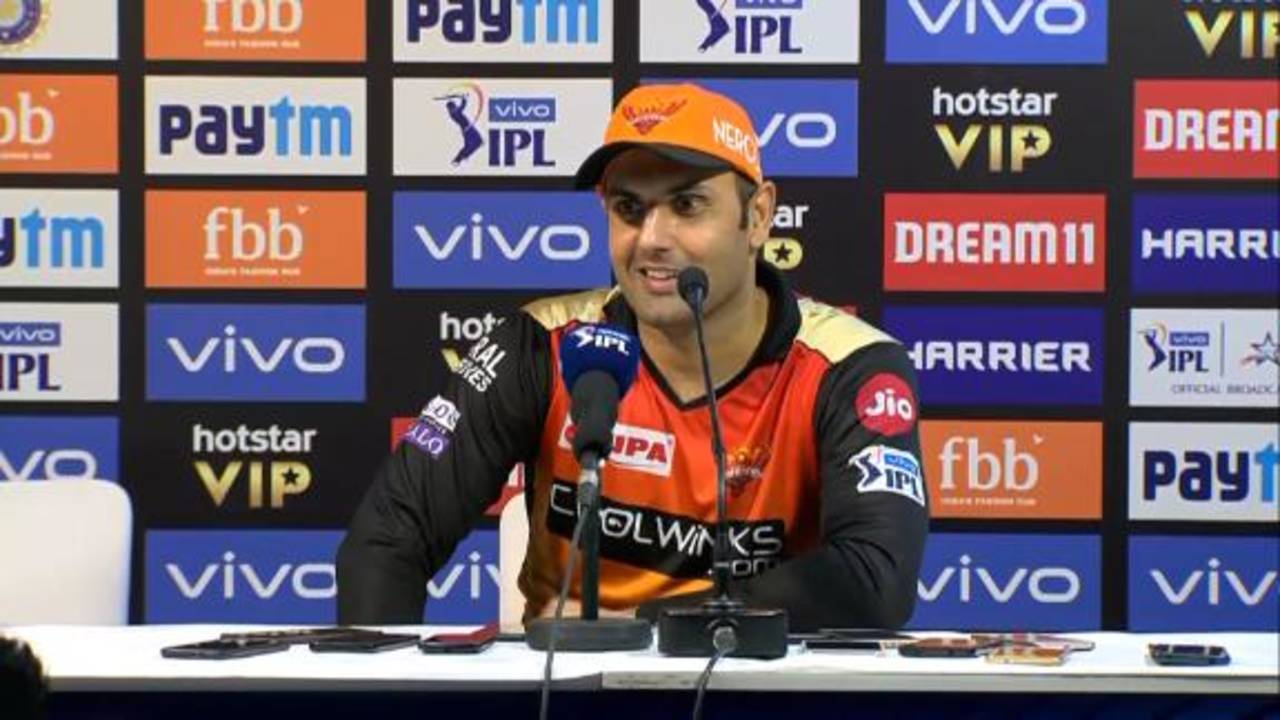Monga: How Sunrisers Hyderabad get the best out of Mohammad Nabi
He only plays sporadically, but his team have won seven out of seven when he's featured, a testament to the super-specialisation of skills in T20 cricket
Sidharth Monga in Delhi
04-Apr-2019
In the euphoria around his more illustrious compatriot Rashid Khan and the prevalent trend of mystery spin, Mohammad Nabi is a mostly forgotten Afghan plying the forgotten art of fingerspin. Not at Sunrisers Hyderabad. They use him sparingly, but know exactly when to do so. This is his third season in the IPL, but Nabi has played only seven matches. Sunrisers have won all seven of them.
Since his arrival in the IPL, Nabi holds the best economy rate among fingerspinners who have bowled 100 or more balls in the IPL - 5.7 - and the second-best average - 15.22. The man ahead of him in average is another sparingly used bowler: Pawan Negi, who has played only 14 matches in two seasons. These spinners have the advantage of playing only when the conditions and match-ups suit them, but Nabi has shown he is ready every time.
"We have played with each other for three years now," Nabi said after Sunrisers' five-wicket win. "We understand the team combination, and understand we will not play every match. I am always ready to give my 100% whenever I get the chance."
Nabi's experience came to the fore on a turning pitch. Asked how he goes about his bowling in a wristspin- and mystery-spin-dominated world order, Nabi said: "I read batsmen. I try to do the last thing the batsmen want me to do. Read what the batsman is trying to do, read what the conditions are doing, and then bowl accordingly. Here the ball was turning so I tried to turn it less."
Nabi is an old-fashioned cricketer's cricketer. The deviation between his good days and bad is not big. He is always there when you look around for solidity. He is a safe fielder and a calm batsman, but it is when he bowls that his old-school values are best seen. Properly side-on, proper pivot, a complete follow-through. Consequently, he gets the ball to drift and dip, which has unfortunately not been enough for fingerspinners in limited-overs cricket of late, with hitting skills breaking too far away from bowlers.

How far can Mohammad Nabi extend his run as Sunrisers Hyderabad's lucky charm?•ESPNcricinfo Ltd
The left-arm spinner and Nabi's Sunrisers team-mate Shakib Al Hasan - basically the mirror image of everything Nabi is - still has the advantage of taking the ball away from the majority of batsmen. It is a difficult time for offspinners who don't bowl mystery balls, but Sunrisers have still used Nabi perfectly. They are the best example of using their resources tactically and in a super-specialised manner. The 2016 IPL final is a great example of that, when the left-arm spinner Bipul Sharma came out of nowhere, played the match, got AB de Villiers, and then didn't even need to bowl out.
ALSO READ - Why T20 franchises make room for impact players
This year, Kane Williamson's absence has given Nabi room to go from super-specialist to specialist. The ploy seems clear: if a pitch is going to grip and if the opposition has a decent number of left-hand batsmen, Nabi gets a go. Otherwise Shakib plays. Nabi's stats say as much. In all T20 cricket this year, he averages 9.37 against left-hand batsmen and 36 against right-hand batsmen. There is a big difference in economy rate too: 5.62 to 7.04.
In Delhi, on a slow pitch with some grip, and against a line-up reliant on three left-hand batsmen, Nabi was going to be a shoo-in. He nearly got Shikhar Dhawan lbw first ball. The next ball dipped on Prithvi Shaw, who still shaped up for a big hit despite not being close to it, but the turn in the pitch told him he couldn't. Nabi now know he didn't need to do anything fancy. That if he beat the batsmen in the air, the pitch would also help him. He became an equal threat to right-hand batsmen.
Three of Nabi's overs were bowled inside the Powerplay, never an easy time for a spinner. His third came in what is traditionally the most difficult over of a Powerplay: the sixth. In this over he benefited from the pressure that his tight bowling in the earlier overs had created. The dip and turn undid Dhawan with the last ball of the Powerplay, and on his return he again beat Rishabh Pant in the air to get him to offer a catch at long-off.
This wicket summed up how difficult it is for fingerspinners. Nabi bowled this slow, got some dip on the ball, beat Pant in the air, and yet it nearly went for six. Even as Nabi put a finishing touch on a match-winning spell, there was a reminder why fingerspinners - especially right-arm - are specialists now, used sparingly, based on conditions and match-ups.
Sidharth Monga is an assistant editor at ESPNcricinfo
